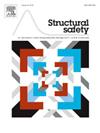Serviceability limit state target reliability for concrete structures
IF 6.3
1区 工程技术
Q1 ENGINEERING, CIVIL
引用次数: 0
Abstract
The balance between safety and economy, referred to as target reliability, forms the basis of modern structural design. Target reliability is determined by economic minimisation, either directly through generic cost optimisation or by back calibration to existing practice. However, the currently codified annual target reliability indices for serviceability limit state (SLS), differ by as much as between those from generic cost optimisation and back calibration. Various assumptions are made in the generic cost optimisation which may not be appropriate to determine SLS target reliability. Target reliability from back calibration is likely to be closer to actual SLS failure rates, however, no literature exists which details the process or rationale by which the back calibration was performed. It is therefore uncertain if either of these methods produce cost optimal SLS target reliability. This research aims to evaluate currently codified SLS target reliability for cost optimality. SLS failure costs from existing research and engineering practice are used with an amended cost optimisation procedure which overcomes the deficiencies identified in the generic formulation to specifically determine SLS target reliability. The amended cost optimisation also considers parameter variation and decision parameter form for typical SLS cases. Results indicate that overall, the target reliability indices for annual irreversible SLS from back calibration to existing practice () represents the range of considered SLS cases () well, whereas those from generic cost optimisation are notably lower (). In some cases, target reliability varied sufficiently from to warrant adjustments being made for better cost optimality.
混凝土结构的使用能力极限状态目标可靠性
安全与经济之间的平衡,即目标可靠度,是现代结构设计的基础。目标可靠性由经济最小化决定,要么直接通过一般成本优化,要么通过对现有实践的反向校准。然而,目前编制的可用性极限状态(SLS)年度目标可靠性指标在通用成本优化和反向校准之间的差异高达Δβ=1.6。在通用成本优化中做出的各种假设可能不适合确定SLS目标的可靠性。反向校准的目标可靠性可能更接近实际的SLS故障率,然而,没有文献详细说明进行反向校准的过程或基本原理。因此,这两种方法是否产生成本最优的SLS目标可靠性是不确定的。本研究旨在评估目前已编纂的SLS目标的成本最优可靠性。从现有的研究和工程实践中得出的SLS失效成本与修正的成本优化程序一起使用,该程序克服了通用配方中确定的缺陷,具体确定了SLS目标的可靠性。修正后的成本优化还考虑了典型SLS案例的参数变化和决策参数形式。结果表明,总体而言,从反校准到现有实践的年度不可逆SLS目标可靠性指数(β=2.9)很好地代表了考虑的SLS情况范围(2.5≤β≤3.3),而通用成本优化的目标可靠性指数明显较低(1.3≤β≤2.3)。在某些情况下,目标可靠性在2.9之间变化很大,需要进行调整以获得更优的成本。
本文章由计算机程序翻译,如有差异,请以英文原文为准。
求助全文
约1分钟内获得全文
求助全文
来源期刊

Structural Safety
工程技术-工程:土木
CiteScore
11.30
自引率
8.60%
发文量
67
审稿时长
53 days
期刊介绍:
Structural Safety is an international journal devoted to integrated risk assessment for a wide range of constructed facilities such as buildings, bridges, earth structures, offshore facilities, dams, lifelines and nuclear structural systems. Its purpose is to foster communication about risk and reliability among technical disciplines involved in design and construction, and to enhance the use of risk management in the constructed environment
 求助内容:
求助内容: 应助结果提醒方式:
应助结果提醒方式:


